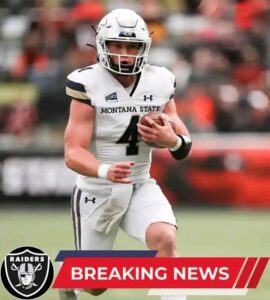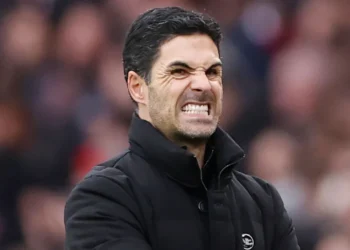Las Vegas may have waited until the sixth round to call Tommy Mellott’s name, but inside league circles the selection felt less like a flier and more like an intentional schematic jolt. The Montana State folk hero—nicknamed “Touchdown Tommy” for the way he commandeered Bobcat offenses to 43 rushing scores—clocked a 4.39-second forty-yard dash at his pro day and leapt 41 inches in the vertical. Those raw numbers would be eye-popping for any draftable wideout; for a college quarterback converting to an all-purpose role, they scream “outlier.”
Why NFL evaluators keep tagging Mellott as “unique”
Positional résumé: Mellott started 32 collegiate games at quarterback, yet the Raiders officially announced him as a wide receiver when they turned in card No. 213. Few prospects since Julian Edelman have entered the league with that combination of pass-game IQ and after-catch explosiveness.

Movement profile: On tape, scouts saw a multi-directional runner who routinely froze FCS defenders with hop-cuts, then re-accelerated like a tailback. The 4.39 speed quantified what the film hinted: in space, he covers grass faster than most NFL slot receivers.
Vertical capability: A 41″ jump matters in Las Vegas because new offensive coordinator Chip Kelly (hired in February after two collegiate stops at UCLA and Oregon) layers his spacing concepts with downfield slot seams. Mellott’s basketball-caliber elevation makes him a live target on pop passes and goal-line fades.
How Chip Kelly plans to weaponize the rookie
Kelly’s playbooks have always featured a “joker” position—the movable chess piece Oregon fans once knew as De’Anthony Thomas and 49ers fans briefly glimpsed with Darren Sproles. Raiders insiders say Mellott is ticketed for that package on Day 1: orbit motions, slot bubbles, jet sweeps, and the occasional hand-off-or-throw wrinkle that forces defenses to tackle the play twice on pre-snap reads.
An AFC West pro scout offered this comparison: “Think Taysom Hill, but 20 pounds lighter and quite a bit twitchier.” Where Hill bulled through linebackers as a quasi-power back, Mellott threatens edges with pure acceleration, then punishes safeties who overplay run keys by lofting a backside throw. Kelly can call his traditional inside-zone RPO, but instead of Jimmy Garoppolo reading the end, he can motion Mellott across the formation, snap the ball, toss the mesh to Mellott, and suddenly the read man must choose between sprint speed outside and a pop pass behind him.
Special-teams upside—why coordinators are already lobbying
Las Vegas ranked 27th in punt-return average last season, prompting special-teams boss Tom McMahon to pound the table for an electric returner. Mellott took only four punts at Montana State, yet his open-field vision on quarterback draws convinced McMahon that the learning curve will be short. The plan is to give him the primary punt-return job in preseason and sprinkle kickoff duties as comfort grows. “If he fields the ball cleanly,” one team source said, “he’s on the 53 regardless of what happens at receiver.”
The quarterback question that just won’t die
Although the Raiders list Mellott as WR / KR, both Antonio Pierce and Kelly have acknowledged they’ll carve out a short-yardage sub-package. Expect it to debut in joint practices against the Rams in August: Mellott aligned in shotgun with two tight ends, read-option footwork, quick pitch potential, and a backside slant tagged for Davante Adams if the safety spins down. During red-zone drills at Montana State, Mellott posted a 33–5 TD-to-turnover margin running similar concepts.
“Don’t look at him as a trick-play guy,” Kelly told local reporters after rookie camp. “Look at him the way the Saints deploy Hill: someone who makes the defense practice extra stuff every week.”
Obstacles between niche gadget and legitimate contributor
Press-man technique: Transitioning from quarterback to NFL slot receiver means defeating nickel corners who live for hand-fighting. Mellott spent the first minicamp focusing on foot-fire releases and swipe moves with position coach Edgar Bennett.
Route depth timing: Quarterbacks inherently understand where a dig should land on the hash, but executing that stem with the right stride length is new muscle memory. The staff inserted him into the “choice” package—option routes requiring instant post-snap reads—to accelerate that education.

Protecting a 200-pound frame: At 6’0″, 200 lbs, he’s sturdy for a receiver but a bit light for designed QB runs. Strength staff are targeting a playing weight of 205–207 by Week 1 to soften NFL collisions.
Why Round-6 value could look obvious in hindsight
Every offseason, rosters churn at the back end; yet sub-4.40 athletes with quarterback brains seldom last past Day 2. Two factors pushed Mellott down boards: FCS competition and positional ambiguity. Las Vegas evaluated both as opportunities rather than red flags. If Mellott becomes Kelly’s mismatch machine while saving a roster spot by doubling as emergency QB3, that is sixth-round gold.
In the wider NFL-media ecosystem, the word “unique” can be overused. Here, it fits. Mellott’s videotape blends Edelman’s body control, Hill’s multi-tool usage, and the straight-line burst of a slot returner. Should even half of that cocktail translate on Sundays, Raider Nation will remember Round 6 of the 2025 draft as the moment the silver-and-black offense found its Swiss Army knife.













